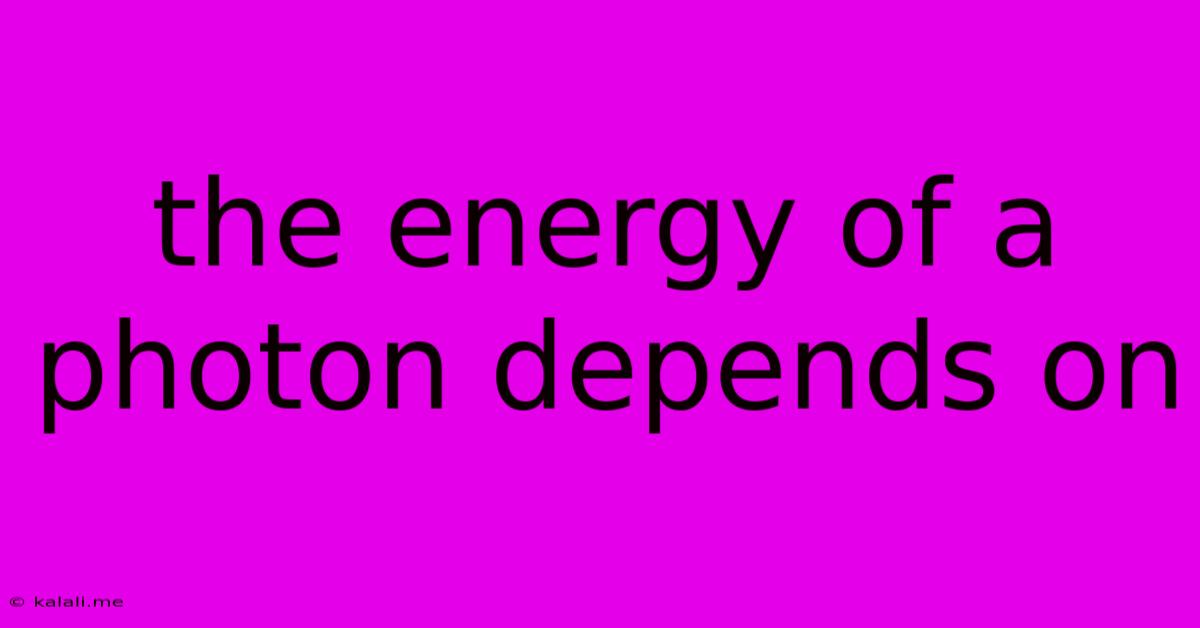The Energy Of A Photon Depends On
Kalali
Jun 16, 2025 · 3 min read

Table of Contents
The Energy of a Photon Depends On: Frequency and Wavelength
The energy of a photon, a fundamental particle of light and other electromagnetic radiation, isn't a fixed value. Instead, it's directly related to its frequency and inversely related to its wavelength. Understanding this relationship is crucial to grasping the nature of light and its interactions with matter. This article delves into the specifics, explaining how these properties define a photon's energy and exploring the implications of this connection.
What is a Photon?
Before diving into the energy calculation, let's briefly review what a photon is. A photon is a fundamental quantum of light, possessing both wave-like and particle-like properties. This dual nature is a cornerstone of quantum mechanics. It doesn't have mass, but it does carry energy and momentum.
The Equation: E = hf
The energy of a photon (E) is directly proportional to its frequency (f). This relationship is elegantly expressed by the equation:
E = hf
where:
- E represents the energy of the photon (typically measured in Joules)
- h is Planck's constant, a fundamental physical constant approximately equal to 6.626 x 10^-34 Joule-seconds.
- f represents the frequency of the photon (typically measured in Hertz, or cycles per second).
This equation reveals that higher frequency photons carry more energy. Think of it like this: a radio wave has a low frequency and therefore low energy, while a gamma ray has an extremely high frequency and correspondingly high energy.
The Relationship with Wavelength
While the equation above uses frequency, we can also express the energy of a photon in terms of its wavelength (λ). Frequency and wavelength are inversely proportional, related by the speed of light (c):
c = fλ
where:
- c is the speed of light in a vacuum, approximately 3 x 10^8 meters per second.
- λ is the wavelength of the photon (typically measured in meters).
By substituting f = c/λ into the energy equation, we get:
E = hc/λ
This equation demonstrates the inverse relationship: shorter wavelengths correspond to higher energy photons, and longer wavelengths correspond to lower energy photons. A violet photon, with its shorter wavelength, has more energy than a red photon with its longer wavelength.
Implications and Applications
The dependence of photon energy on frequency and wavelength has profound implications across numerous scientific fields:
- Spectroscopy: Analyzing the light emitted or absorbed by atoms and molecules allows scientists to determine their energy levels and identify substances. Different elements emit and absorb light at specific wavelengths, providing a unique "fingerprint."
- Photoelectric Effect: This phenomenon, where light shining on a metal surface ejects electrons, demonstrates the particle nature of light. Only photons with sufficient energy (above a certain threshold frequency) can eject electrons, regardless of the intensity of the light.
- Medical Imaging: Techniques like X-ray and gamma-ray imaging utilize high-energy photons to penetrate tissues and create images. The different absorption of these photons by different tissues allows for diagnosis and treatment.
- Solar Energy: Solar panels harness the energy of photons from sunlight to generate electricity. The efficiency of these panels depends on their ability to absorb photons across a range of wavelengths.
In conclusion, the energy of a photon is intrinsically linked to its frequency and wavelength. This fundamental relationship is a cornerstone of modern physics and has far-reaching applications in various scientific and technological fields. Understanding this connection allows us to interpret the behavior of light and harness its power for numerous applications.
Latest Posts
Latest Posts
-
How To Create Clickable Image In Html
Jun 16, 2025
-
What Are The Factors Of 121
Jun 16, 2025
-
What Is A Theme Of The Passage
Jun 16, 2025
-
A Company That Provides Access To The Internet
Jun 16, 2025
-
Which Word Is Closest In Meaning To The Underlined Word
Jun 16, 2025
Related Post
Thank you for visiting our website which covers about The Energy Of A Photon Depends On . We hope the information provided has been useful to you. Feel free to contact us if you have any questions or need further assistance. See you next time and don't miss to bookmark.